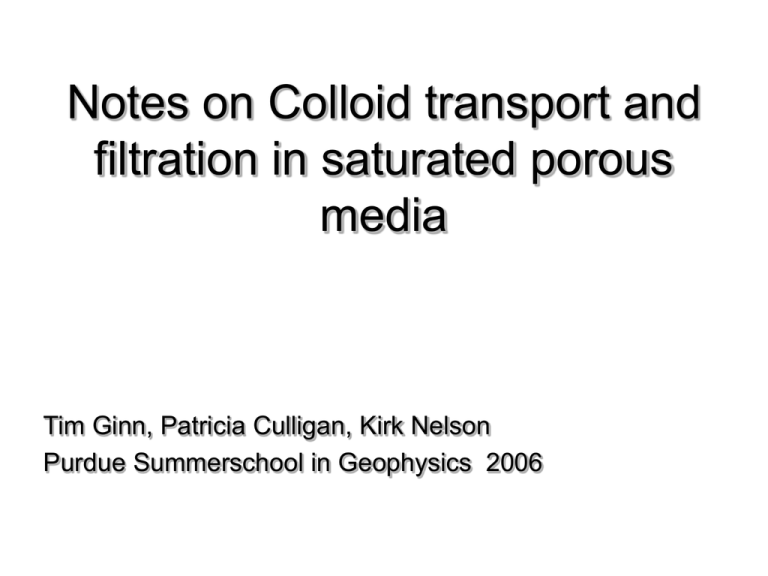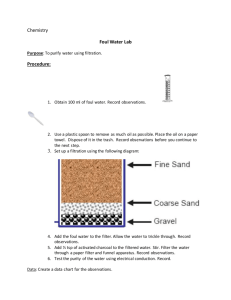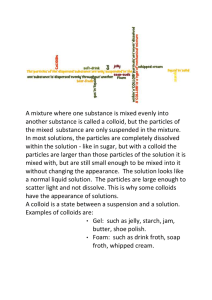Notes on Colloid transport and filtration in saturated porous media
advertisement

Notes on Colloid transport and filtration in saturated porous media Tim Ginn, Patricia Culligan, Kirk Nelson Purdue Summerschool in Geophysics 2006 But first, we start with Brief review of general reactive transport formalism Outline General reactive transport intro Multicomponent/two-phase/multireaction colloid filtration “Miller lite” Stop and smell the characteristic plane - mcad Colloid Filtration “Guiness” Overview Processes catwalk Classical approach Blocking Issues Return to macroscale: multisite/population Gone to mathcad Some analytical solutions - hope it runs Just transport Irreversible filtration no dispersion Reversible filtration no dispersion (Dispersion included by superposition.) Outline General reactive transport intro Multicomponent/two-phase/multireaction colloid filtration “Miller lite” Stop and smell the characteristic plane - mcad Colloid Filtration “Guiness” Overview of colloids in hydrogeology Processes catwalk Classical approach Blocking Issues Return to macroscale: multisite/population 1. Introduction - Background Particle Sizes -10 (diameter, m) 10 1Å 10-9 10-8 10-7 10-6 1 nm 10-5 10-4 1 mm Soils Clay 10-3 10-2 1 mm 1 cm Sand Silt Gravel Microorganisms Viruses Protozoa Red blood cell Blood cells Atoms, molecules Bacteria White blood cell Atoms Molecules Macromolecules Colloids Suspended particles Depth-filtration range Electron microscope Light microscope Human eye Problems Involving Particle Transport through Porous Media in Environmental and Health Systems Water treatment system Deep Bed Filtration (DBF) Membrane-based filtration Transport of pollutants in aquifers Colloidal particle transport1 Colloid-facilitated contaminant transport2 Transport of microorganisms 1. 2. Pathogen transport in groundwater Bioremediation of aquifers … Ryan, J.N., and M. Elimelech. 1996. Colloids Surf. A, 107:1–56. de Jonge, Kjaergaard, Moldrup. 2004. Vadose Zone Journal, 3:321–325 …and some more In situ bioremediation transport of bacteria to contaminants1 excessive attachment to aquifer grains – biofouling Bacteria-facilitated contaminant transport (e.g.,DDT2) Clinical settings 1. 2. Blood cell filtration Bacteria and viruses filtration Ginn et al., Advances in Water Resources, 2002, 25, 1017-1042. Lindqvist & Enfield. 1992. Appl. Environ. Microbiol, 58: 2211-2218. Outline General reactive transport intro Multicomponent/two-phase/multireaction colloid filtration “Miller lite” Stop and smell the characteristic plane - mcad Colloid Filtration “Guiness” Overview Processes catwalk Classical approach Blocking Issues Return to macroscale: multisite/population Processes in colloid-surface interaction Actual colloid, Inertia in (arbitrary) velocity field Torque, drag due to nonuniform flow Diffusion, hydrodynamic retardation/lubrication Effective increase in viscosity near surface Electrostatic (dynamic) interaction DLVO (=LvdW + doublelayer model electrostatics) Buoyancy/gravitational force Overview General reactive transport intro Multicomponent/two-phase/multireaction colloid filtration “Miller lite” Stop and smell the characteristic plane - mcad Colloid Filtration “Guiness” Overview Processes catwalk Classical approach – “Colloid filtration theory” and some Details Blocking Issues Return to macroscale: multisite/population Classical take on Processes in colloid-surface interaction Inert, Spherical colloid to Sphere (flat) Inertia in (Stokes) velocity field Torque, drag due to nonuniform flow approximated Diffusion (superposed) hydrodynamic retardation/lubrication Electrostatic (dynamic) interaction DLVO (=LvdW + doublelayer model electrostatics ) Buoyancy/gravitational force added So flow must be downward Forces And Torques – RT model Trajectory Analysis Smoluchowski-Levich Solution (particle has finite diameter) (particle diameter = 0) TD TD FG h + = FB FI = inertial force due to Stokes flow* FD = drag force due to Stokes flow* TD = drag torque due to Stokes flow* FG = gravitational force FB = buoyancy force FvdW = van der Waals force *with corrections near surface FI = inertial force due to Stokes flow FD = drag force due to Stokes flow TD = drag torque due to Stokes flow FBR = random Brownian force Classical CFT :Happel spherein-cell Clean-bed “Filtration Theory” • Single “collector” represents a solid phase grain. A fraction h of the particles are brought to surface of the collector by the mechanisms of Brownian diffusion, Interception and/or Gravitational sedimentation. •A fraction of the particles that reach the collector surface attach to the surface (electrostatic and ionic strength) • The single collector efficiency is then “scaled up” to a macroscopic filtration coefficient, which can be related to first-order attachment rate of the particles to the solid phase of the medium. h0 h D h I hG Single collector efficiency h Filtration coefficient First-order deposition rate 3(1 n) h 2dc katt u Bulk “kf” by classical filtration theory nC f c kC t 3 1 n U k h n 2 d c First-order removal Rate = filter coefficient * porewater velocity => two-step process n porosity C aqueous phase concentration of colloid suspension fc flux of C U groundwater (Darcy) specific flux fraction of colloids encountering solid surface that stick (empirical2,3) h fraction of aqueous colloids that encounter solid surface (modeled1,3-6) 1. Rajagoplan & Tien. 1976. AIChE J. 22: 523-533. 2. Harvey & Garabedian. 1991. ES&T 25: 178-185. 3. Logan et al. 1995. J. Environ. Eng. 121: 869-873. 3. Nelson & Ginn. 2001 Langmuir 17: 5636-5645 4. Tufenkji & Elimelech. 2004 ES&T 38: 529-536. 5. Nelson & Ginn. 2005 Langmuir 21: 2173-2184 Details1:Happel sphere-in-cell model2 Happel sphere-in-cell is porous medium Stokes’ flow field h calculated via trajectory analysis1 Additive decomposition h=hI+hG+hD Initial point of limiting trajectory h = A1/A2 = sin2qs 1. Rajagoplan & Tien. 1976. AIChE J. 22: 523-533. 2. Happel. 1958. AIChE J. 4: 197-201. A1 A2 Detail: Basic solution (analytical) due to Rajagopalan & Tien (1976) Hydrodynamic retardation effect = the increased drag force a particle experiences as it approaches a surface. Interception by boundary a deviation from Stokes’ law condition Hydrodynamic correction factors Sedimentation group Particle velocity expressions gives: 1 U uq r, q B s2 D 1 s3 NG sinq s1 r 1 ur r, q t A 1 fr 2 frm NG cosq London van der Waals group rtd N LO 2 U 2 2 where frt, frm, s1, s2, and s3 are the drag correction factors. Detail: h vs. irreversible adsorption constant, kirr = f(,h) h = fraction of colloids contacting solid phase, calculated a priori from RT model = fraction of colloids contacting solid phase that stick, treated as a calibration parameter accounting for all forces and mechanisms not considered incalculation of h Role of electrostatic forces : aside Detail: Surface Forces in CFT – DLVO RT model uses DLVO theory for surface interaction forces: attractive repulsive for like charges potential = van der Waals + double layer Theory predicts negligible collection when repulsive surface interaction exists RT model neglects double layer force. Detail: Surface Forces in CFT – DLVO RT model uses DLVO theory for surface interaction forces: attractive repulsive for like charges potential = van der Waals + double layer Theory predicts negligible collection when repulsive surface interaction exists RT model neglects double layer force. Thus, double layer force implicit in . Highlights of Formulae for h Yao (1971) hydrodynamic retardation and van der Waals force not included Rajagopalan and Tien (1976) deterministic trajectory analysis torque correction factors Brownian h added on separately from Eulerian analysis Tufenkji and Elimelech (2004) convective-diffusion equation solution influence of van der Waals force and hydrodynamic retardation on diffusion fc UC D C D f kT Diffusion, interception, & sedimentation considered additive Nelson and Ginn (2005) C Particle tracking in Happel cell – all forces together Outline General reactive transport intro Multicomponent/two-phase/multireaction colloid filtration “Miller lite” Stop and smell the characteristic plane - mcad Colloid Filtration “Guiness” Overview Processes catwalk Classical approach – “Colloid filtration theory” and some Details Blocking Issues Return to macroscale: multisite/population Dynamic surface blocking (ME) initial deposition rate (kinetics) rate a kc 2 p later, when deposition rate drops due to surface coverage (dynamics) rate a kB(s)c 2 p retained particles block sites, B is the dynamic blocking function (misnomer). B's B = fraction of particle-surface collisions that involve open seats (cake walk). Random Sequential Adsorption 40 176 3 Bs 1 4ss ss 2 s s 3 3 6 3 2 Power series in S, for spherical geometry Langmuirian Dynamic Blocking Bs 1 s 1/ s Outline General reactive transport intro Multicomponent/two-phase/multireaction colloid filtration “Miller lite” Stop and smell the characteristic plane - mcad Colloid Filtration “Guiness” Overview Processes catwalk Classical approach – “Colloid filtration theory” and some Details Blocking Issues Return to macroscale: multisite/population Issues CFT coarse idealized model Chem/env. Engineering, not natural p.m. Biofilms, organic matter, asperities, heterogeneity (gsd, psd, surface area, electrostatic (dynamic), transience, flow reversal, temperature, etc. Reversibility ??? CFT good for trend prediction Attachment goes up with colloid size, gw velocity, ionic strength, etc. Ultimately need equs for bulk media Lab field Outline General reactive transport intro Multicomponent/two-phase/multireaction colloid filtration “Miller lite” Stop and smell the characteristic plane - mcad Colloid Filtration “Guiness” Overview Processes catwalk Classical approach – “Colloid filtration theory” and some Details Blocking Issues Return to macroscale: See the data ! Field/Lab observations Microbes 1,2,3 and viruses 4,5 first showed apparent multipopulation rates due to decreased attachment with scale Sticky bugs leave early Readily explained by subpopulations Some suggest geochemical “heterogeneity” Recent surprize is that inert monotype, monosize and polysize colloids exhibit same6 1. 2. 3. 4. 5. 6. Albinger et al., FEMS Microbio Ltr., 124:321 (1994) Ginn et al., Advances in Water Resources, 25:1017 (2002). DeFlaun et al., FEMS Microbio Ltr., 20:473 (1997) Redman et al., EST 35:1798 (2001); Schijven et al., WRR 35:1101 (1999) Bales et al., WRR 33:639 (1997) Li et al., EST 38:5616 (2004); Tufenkji and Elim. Langmuir 21:841 (2005)Yoon et al., WRR June 2006 Ability-based modeling (because we can) BTCs (first) exhibit long flat tails Two-site, multisite model1 (google “patchwise”) Two-population, multipop’n model2 (UAz, Arnold/Baygents) Can’t tell the difference Profiles (recently) are steeper than expected 1. 2. 3. Multipopulation works, not multisite (Li et al in 2), 3 This is the location of the front in practice Upscaling Alternative explanations E.g., Sun et al., WRR 37:209 (2001); “patchwise heterogeneity”, CXTFIT ease of use (sorta) E.g., Redman et al., EST 35:1798 (2001); Li et al. EST 38:5616 (2004) Johnson and Li, Langmuir 21:10895 (2005); Comment/Reply Research Needs (at least) Formal upscaling Forces complex but well understood Approximations tested Analytical results (Smoluchowski-Levitch1) Alternative explanations C<-> S -> S’ surface transformations 2 Mainly bacteria; need RTD for attachment events Physical straining of larger sizes (a pop’n model)3 Reentrainment4 Contact (CFT) and surface (multipopn) filtration5 1. For CFT/Happel cell without interception or sfc forces (LvdW =-hyd. Retardation) 2. Davros & van de Ven JCIS 93:576 (1983); Meinders et al. JCIS 152:265 (1992); Johnson et al. WRR 31: 2649 (1995); Ginn WRR 36:2895 (2000) 3. Bradford et al WRR 38:1327 (2002); Bradford et al. EST 37:2242 (2003) 4. Grolimund et al WRR 37:571 (2001) 5. Yoon et al. WRR June 2006 Appendix: DNS Approach Langevin equation of motion Happel sphere-in-cell Contemporaneous accounting of all forces Solution per colloid Calculating h Monte carlo colloidal release per qs => P(qs) frequency of attachment per qs h as an expectation over P(qs) Langevin Equation Deterministic and Brownian displacements are combined per time step: du mp Fh Fe Fb dt mp is the particle mass, u is the particle velocity vector, Fh is the hydrodynamic force vector, Fe is the external force vector, and Fb is the random Brownian force vector. All three components of random displacement must be modeled in the axisymmetric (3D 2D) flow field. Solution R udet Dt ns R R = 3D displacement, udet = deterministic velocity vector n =3 N(0,1), sR = standard deviations of Brownian displacements. negligible particle inertia assumed Dt >> tB (Kanaoka et al., 1983) tB particle’s momentum relaxation time (=mp/6map). Thus, tB << Dt < tu tu is the time increment at which udet is considered con Highlights of numerical solution Stokes’ flow in two-dimensions R&T (1976) hydrodynamic drag correction factors1 Brownian diffusion algorithm of Kanaoka et al. (1983)2 for diffusive aerosols Coordinate transformation to 2D model 1. Brenner, H., Chem. Eng. Sci. 1961, 16, 242-251; Dahneke, B.E., J. Colloid Interface Sci., 1974, 48, 520-522. 2. Kanaoka, C.; Emi, H.; Tanthapanichakoon, W., AIChE J., 1983, 29, 895-902. Coordinates for diffusion The Happel model: 3-D -> 2-D polar coordinates convert 3-D Brownian Cartesian displacement to spherical, to polar ˜ ˜ y ny 2DB MDt ˜ z nz 2 DBM Dt Rx nx 2DBM Dt R R y,z, contribute to angular displacements And thus to r R˜ y ˜ q arcsin R r R˜ z ˜ arcsin R r 2 ˜ 2 ˜ ˜R R ˜ r 1 sin Rq 1 sin R 2r r x Calculating h / 2 h2 Pcollect qS sin qS cosqS dqS 0 qS starting angle of a colloid Pc(qS) frequency of contact with the collector. reduces to classical equation when deterministic (e.g., when Pc(qS) equals one for all qS < qLT and zero for all qS > qLT). task of stochastic trajectory analysis for h is to find Pc(qS). Colloid transport and Colloid Filtration Theory Classical approach Issues Direct numerical simulation: Approach Examples, Convergence, Testing Results Blocking - pages from Elimelech's site Conclusions Example Brownian Trajectory 1.6429E-04 1.6428E-04 1.6427E-04 1.6426E-04 r [m] 1.6425E-04 1.6424E-04 1.6423E-04 1.6422E-04 1.6421E-04 1.6420E-04 1.6419E-04 1.1838 1.184 1.1842 1.1844 1.1846 q [rad] 1.1848 1.185 1.1852 1.1854 1.1856 164.44 164.39 164.34 r [ m m] 164.29 164.24 164.19 1.132 1.134 1.136 1.138 1.14 q [rad] 1.142 1.144 1.146 P(qs) Num ber of bacteria collected w ith (Brow nian m otion included) as function of theta-start 0.025 Bacteria collected ran1 300 rlzns ran1 1000 rlzns MT 12K rlzns ran1 12K rlzns 0.020 0.015 0.010 0.005 0.000 0 0.01 0.02 0.03 0.04 0.05 0.06 0.07 theta-start 0.08 0.09 0.1 0.11 0.12 Convergence of a trajectory - 50K realizations Convergence of Collection Freq from ts=.0418 (Case 1, ap = .695 microns, dt = 0.5 msec) 1 0.9 0.8 Frequency of collection 0.7 0.6 0.5 0.4 0.3 0.2 0.1 0 1 10 100 1000 number of realizations 10000 100000 Convergence to deterministic trajectory analysis of Rajagopalan and Tien (when diffusion is neglected), Parameters: e = 0.2, as = 50 mm, ap = 0.1 mm, and U = 3.4375 * 10-4 m/s. The approximate analytical solution is h = 1.5 NR2g2AS (Rajagopalan and Tien, 1976). Convergence of stochastic simulations for Smoluchowski-Levich approximation. Parameters: ap = 0.1 mm, as = 163.5 mm, e = 0.372, U = 3.4375*10-4 m/sec, m = 8.9*10-4 kg*m/sec, T = 298 K. 8.4E-03 8.3E-03 Dt = 10 ms 8.2E-03 analytical result D t = 1 ms 8.1E-03 Dt = 100 8.0E-03 h 7.9E-03 7.8E-03 7.7E-03 7.6E-03 7.5E-03 7.4E-03 0 2000 4000 6000 number_of_realizations 8000 10000 12000 Colloid transport and Colloid Filtration Theory Classical approach Issues Direct numerical simulation: Approach Convergence Results Smoluchowski-Levitch approximation General case Blocking - pages from Elimelech's site Conclusions Testing comparison to the Smoluchowski-Levich approximation (external forces, interception neglected). Parameters: as = 163.5 mm, e = 0.372, U = 3.4375*10-4 m/sec, m = 8.9*10-4 kg*m/sec, T = 298 K, Dt = 1 ms, N = 6000. 1.E-02 NG04 analytical h 1.E-03 0 0.2 0.4 0.6 m) ap (m 0.8 1 1.2 Comparison of h calculations R&T (1976) X N&G - - - T&E (2004) o N&G Additive RT_76 NG_04 TE_04 NG_04 additive RT_76 deterministic NG_04 deterministic R&T (1976) deterministic N&G deterministic 1E-02 h 1E-03 1E-04 0.2 0.3 0.4 0.5 0.6 0.7 ap (mm) 0.8 0.9 1 1.1 Conclusions Lagrangean analysis is viable tool with modern computers Stochastic trajectory analysis suggests diffusion and sedimentation may not be additive More realistic “unit cell” models could be used Lagrangean approach allows for arbitrary interaction potentials Chemical (mineralogical, patchwise) heterogeneity Exocellular polymeric substances in bacteria Polymer bridging, hysteretic force potentials Parameters used in stochastic trajectory simulations. Parameter Value Collector radius, as 163.5 mm Porosity, e 0.372 Approach velocity, U 3.4375 * 10-4 sec Fluid viscosity, m 8.9 * 10-4 kg·m / sec Hamaker constant, H 10-20 J Bacterial density, rp 1070 kg / m3 Fluid density, rf 997 kg / m3 Absolute temperature, T 298 K Time step, Dt 1 ms Number of realizations, N 6000 Modification of CFT to Account for EPS Distribution of polymer lengths on the cell surface Repulsion modeled by steric force, Fst(h)1,2 Hypothetical cell (drawn to scale) O L depends on polymer density and brush length KT2442 L E 0.695 mm If sufficient polymers contact collector, cell attaches depends on polymer density, length, and adhesion forces C h C T O R mean polymer length = 160 nm 1. de Gennes. 1987. Adv. Colloid Interface Sci. 27: 189-209. 2. Camesano & Logan. 2000. Environ. Sci. Technol. 34: 3354-3362. Theoretical Sticking Efficiency Numerical Calculation of Trajectories Steric repulsive force Polymer bridging Interception Sedimentation Brownian motion London van der Waals attractive force Hydrodynamic retardation effect Incorporation of Brownian motion and polymer interactions into trajectory analysis allows for computation of a theoretical sticking efficiency. Theoretical Sticking Coefficient Incorporation of polymer interactions and Brownian motion + assumption that polymers control adhesion Trajectory analysis yields the product [h]theo = A1/A2 =sin2 qs Then we can define a theoretical value for the sticking efficiency : theo = [h]theo / h where h is the model result without polymer interactions. Comparison of theo with experimental can serve as a validation tool for the polymer interaction modeling. Pseudomonas putida KT2442 Considered for bioremediation use1,2 Congo Red stain image heavy EPS coverage on cells EPS characteristics being studied by Camesano et al. (WPI)3 KT2442 cells with Congo Red White areas indicate EPS 1. Nublein et al. 1992. Appl. Environ. Microbiol. 58: 3380-3386. 2. Dobler et al. 1992. Appl. Environ. Microbiol. 58: 1249-1258. 3. Camesano & Abu-Lail. 2002. Biomacromolecules. 3: 661-667. Photo credit: Stephanie Smith Dept. of Land, Air, & Water Resources Summary CFT trajectory analysis modified for explicit inclusion of Brownian motion and bacterial EPS interactions Brownian trajectory analysis results suggest that sedimentation and diffusion may not be additive as previously assumed Future work comparison of h calculations with experimental data in the literature more realistic modeling of EPS interactions (e.g., hysteresis)





